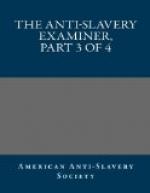Notwithstanding the preceding daily ration in the Buxton Prison is about double the usual daily allowance of our slaves, yet the visiting physicians decided, that for those prisoners who were required to work the tread-mill, it was entirely sufficient. This question was considered at length, and publicly discussed at the sessions of the Surry magistrates, with the benefit of medical advice; which resulted in “large additions” to the rations of those who worked on the tread-mill. See London Morning Chronicle, Jan. 13, 1830.
To the preceding we add the ration of the Roman slaves. The monthly allowance of food to slaves in Rome was called “Dimensum.” The “Dimensum” was an allowance of wheat or of other grain, which consisted of five modii a month to each slave. Ainsworth, in his Latin Dictionary estimates the modius, when used for the measurement of grain, at a peck and a half our measure, which would make the Roman slave’s allowance two quarts of grain a day, just double the allowance provided for the slave by law in North Carolina, and six quarts more per week than the ordinary allowance of slaves in the slave states generally, as already established by the testimony of slaveholders themselves. But it must by no means be overlooked that this “dimensum,” or monthly allowance, was far from being the sole allowance of food to Roman slaves. In addition to this, they had a stated daily allowance (diarium) besides a monthly allowance of money, amounting to about a cent a day.
Now without further trenching on the reader’s time, we add, compare the preceding daily allowances of food to soldiers and sailors in this and other countries; to convicts in this and other countries; to bodies of emigrants rationed at public expense; and finally, with the fixed allowance given to Roman slaves, and we find the states of this Union, the slave states as well as the free, the United States’ government, the different European governments, the old Roman empire, in fine, we may add, the world, ancient and modern, uniting in the testimony that to furnish men at hard labor from daylight till dark with but 1-1/2 lbs. of corn per day, their sole sustenance, is to MURDER THEM BY PIECE-MEAL. The reader will perceive by examining the preceding statistics that the average daily ration throughout this country and Europe exceeds the usual slave’s allowance at least a pound a day; also that one-third of this ration for soldiers and convicts in the United States, and for solders and sailors in Europe is meat, generally beef; whereas the allowance of the mass of our slaves is corn, only. Further, the convicts in our prisons are sheltered from the heat of the sun, and from the damps of the early morning and evening, from cold, rain, &c.; whereas, the great body of the slaves are exposed to all of these, in their season, from daylight till dark; besides




